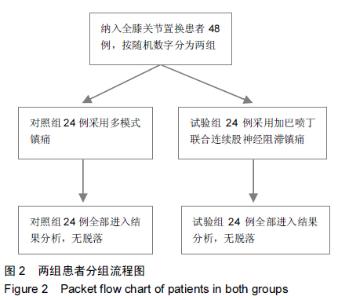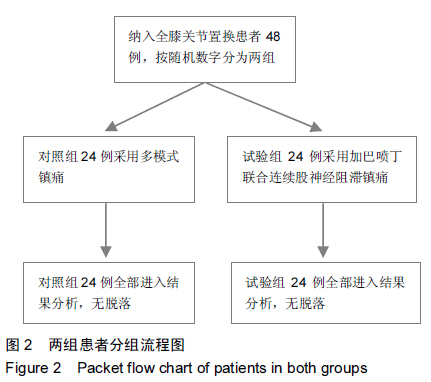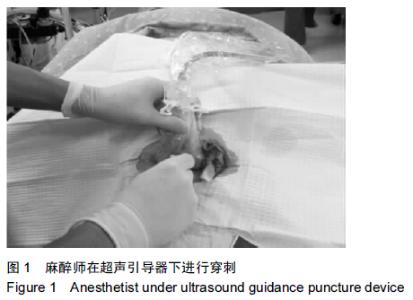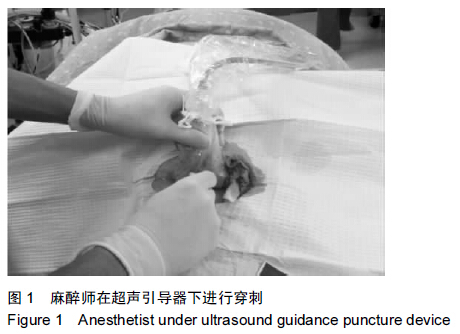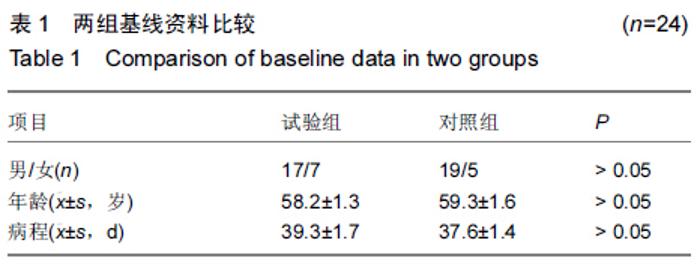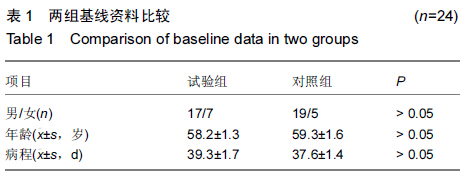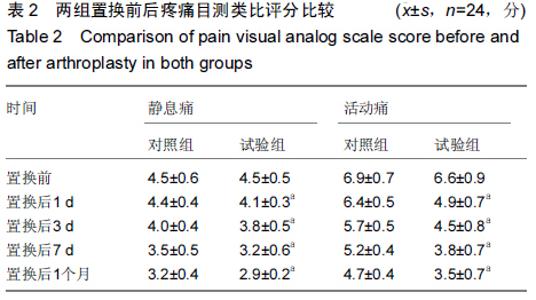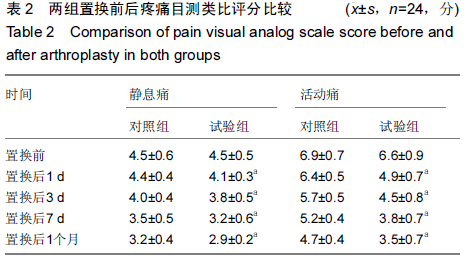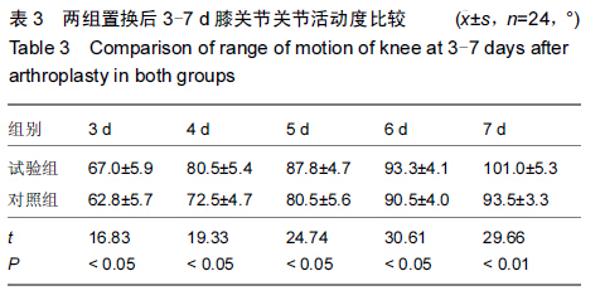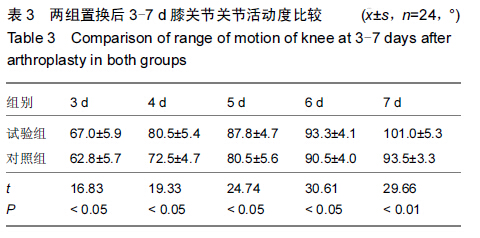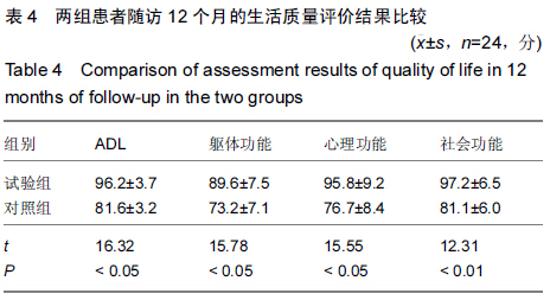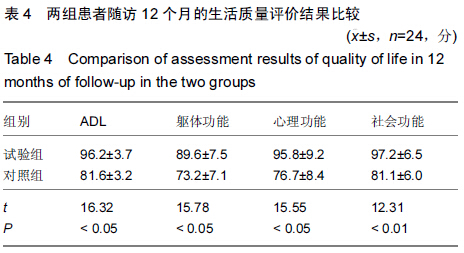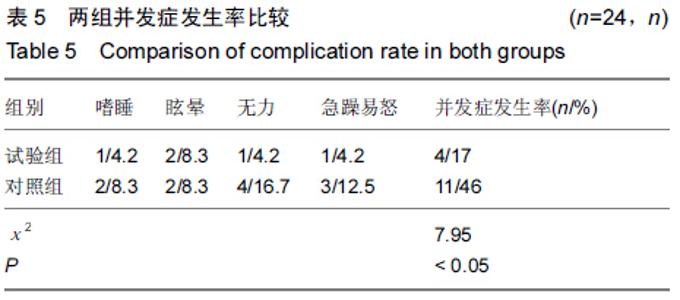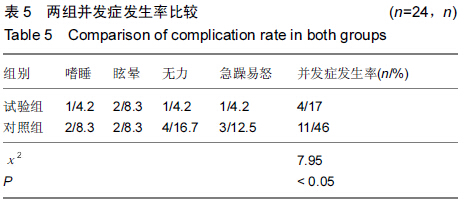Chinese Journal of Tissue Engineering Research ›› 2015, Vol. 19 ›› Issue (44): 7114-7119.doi: 10.3969/j.issn.2095-4344.2015.44.012
Previous Articles Next Articles
Total knee arthroplasty analgesia: gabapentin combined with continuous femoral nerve block
Guo Xiu-zhen1, Gao Bin-li2
- 1Department of Anesthesiology, Affiliated Hospital of Inner Mongolia Medical University, Hohhot 010050, Inner Mongolia Autonomous Region, China; 2Department of Orthopedics, Affiliated Hospital of Inner Mongolia Medical University, Hohhot 010050, Inner Mongolia Autonomous Region, China
-
Received:2015-08-17Online:2015-10-22Published:2015-10-22 -
Contact:Gao Bin-li, Master, Chief physician, Department of Orthopedics, Affiliated Hospital of Inner Mongolia Medical University, Hohhot 010050, Inner Mongolia Autonomous Region, China -
About author:Guo Xiu-zhen, Associate chief nurse, Department of Anesthesiology, Affiliated Hospital of Inner Mongolia Medical University, Hohhot 010050, Inner Mongolia Autonomous Region, China -
Supported by:the Youth Innovation Foundation of Inner Mongolia Medical University, No. YKD2012QNCX017
Cite this article
Guo Xiu-zhen, Gao Bin-li. Total knee arthroplasty analgesia: gabapentin combined with continuous femoral nerve block[J]. Chinese Journal of Tissue Engineering Research, 2015, 19(44): 7114-7119.
share this article
| [1] Dahl JB, Mathiesen O, Moiniche S. Protective premedication: an option with gabapentin and related drugs? An review of gabapentin and pregabalin in the treatment of postoperative pain. Acta Anaesthesiol Scand. 2004; 48: 1130-1136. [2] Dirks J, Fredensborg BB, Christensen D, et al. A randomized study of the effects of single-dose gabapentin versus placebo on postoperative pain and morphine consumption after mastectomy. Anesthesiology. 2002; 97:560-564.
[3] Pandey CK, Priye S, Singh S, et al.Preemptive use of gabapentin significantly decreases postoperative pain and rescue analgesic requirements in laparoscopic cholecystectomy. Can J Anaesth. 2010;51:358-363.
[4] Pandey CK, Singhal V, Kumar M, et al. Gabapentin provides effective postoperative analgesia whether administered pre-emptively or post-incision. Can J Anaesth. 2011;52: 827-831.
[5] Reuben SS, Buvenandran A, Katz B, et al. A prospective randomized trial on the role of perioperative celecoxib administration for total knee arthroplasty: improving clinical outcomes.Anesth Analg. 2008;106: 1258-1264.
[6] 李东文,徐燕,吴海山.全膝关节置换术围手术期疼痛控制现状及思考[J].实用医学杂志,2007,23(18):2814-2815.
[7] 戴文达,殷殿毅,张弛.连续股神经阻滞联合帕瑞昔布用于全膝关节置换术后镇痛的效果评价[J].中国骨与关节外科,2013,6(1): 17-20.
[8] 张昊华,张洪,周一新,等.全膝关节置换术围手术期多模式镇痛方案的临床研究[J].中华骨科杂志,2008,28(8):647-650.
[9] 王思群,夏军,魏亦兵,等.全膝关节置换术围手术期疼痛综合控制的临床研究[J].中华关节外科杂志: 电子版,2008,2(3):32-35.
[10] 潘江,张博,曲铁兵,等.膝关节置换术后连续股神经阻滞镇痛的短期临床效果[J].中华关节外科杂志: 电子版,2014,8(3):319 -323.
[11] 李军,史占军.周围神经阻滞在全膝关节置换镇痛中的应用[J].中华关节外科杂志: 电子版,2012,6(1): 129-131.
[12] 中华医学会骨科学分会.骨科常见疼痛的处理专家建议[J].中华骨科杂志,2008,28(1):78-81.
[13] 贾东林,李水清,南兴东,等.罗哌卡因或利多卡因持续股神经阻滞用于膝关节置换术后康复镇痛的临床研究[J].中国疼痛医学杂志,2008,14(4):214-217.
[14] 闫金洪,汪晨,毕龙.连续股神经阻滞联合关节周围注射用于全膝关节置换术后镇痛及早期功能康复的研究[J].现代生物医学进展,2013,5(13):891-894.
[15] 张爱萍,许旭东.连续股神经阻滞用于全膝置换术后镇痛效果的临床观察[J]. 麻醉与镇痛,2011,34(18):75-77.
[16] Morin AM,Kratz CD,Eberhart LH,et al.Postoperative analgesia and functional recovery after total -knee replacement:comparison of a continuous posterior lumbar plexus(psoas compartment)block,a continuous femoral nerve block,and the combination of a continuous femoral and sciatic nerve block. Reg Anesth Pain Med. 2005;30(5):434-445.
[17] Ittichaikulthol W,Prachanpanich N,Kositchaiwat C,et al.The post-operative analgesic efficacy of celecoxib compared with placebo and parecoxib after total hip or knee arthroplasty. J Med Assoc Thai. 2010;93(8):937-942.
[18] Wang SY,Olson-Kellogg B,Shamliyan TA,et al.Physical therapy interventions for knee pain secondary to osteoarthritis: a systematic review.Ann Intern Med. 2012;157(9):632-644.
[19] Su EP,Perna M,Boettner F,et al.A prospective, multi-center, randomised trial to evaluate the efficacy of a cryopneumatic device on total knee arthroplasty recovery.J Bone Joint Surg Br. 2012;94(11):153-156.
[20] Wang SY, Olson-Kellogg B,Shamliyan TA,et al.Physical therapy interventions for knee pain secondary to osteoarthritis: a systematic review.Ann Intern Med. 2012;157(9): 632-644.
[21] 李丽萍,黄炳强,刘宿,等.老年患者术后认知功能评价与疼痛视觉模拟评分的相关性研究[J].第三军医大学学报,2010,32(11): 1226-1228.
[22] 崔文涛,李国兰,贺昌林.帕瑞昔布钠超前镇痛在腹腔镜子宫次全切除术中的应用[J].浙江实用医学,2011,16(3):205-206.
[23] 米坤龙,韦民.人工膝关节置换术后康复与疼痛治疗[J].山西医药杂志,2007,36(4): 335-336.
[24] 朱长江,赵秀梅,刘亚林,等.帕瑞昔布钠超前镇痛对妇科术后自控硬膜外镇痛效果的影响[J].中国误诊学杂志,2011,11(17): 4044-4046.
[25] 张学政,蒋柳明,徐旭仲,等.帕瑞昔布钠对颌面外科术后芬太尼静脉自控镇痛的影响[J].实用医学杂志,2010,26(20):3803-3805.
[26] 张挺,王睿铸,胡燕军,等.视觉模拟评分法在全膝关节置换术镇痛后应用体会[J].现代生物医学进展,2011,11(22):4362-4363.
[27] 尹东,黄宇,莫冰峰,等.环氧化酶-2 抑制剂在膝关节置换围手术期镇痛及功能康复的作用[J].中华关节外科杂志:电子版,2014, 8(2):171-174.
[28] Abdallah FW,Brull R. Is sciatic nerve block advantageous when combined with femoral nerve block for postoperative analgesia following total knee arthroplasty? A systematic review.Reg Anesth Pain Med. 2011;36(5):493-498.
[29] Beaupre LA,Johnston DB,Dieleman S,et al. Impact of a preemptive multimodal analgesia plus femoral nerve blockade protocol on rehabilitation,hospital length of stay,and postoperative analgesia after primary total knee arthroplasty: a controlled clinical pilot study. Scientific World J. 2012; 2012:273821.
[30] Tanaka N,Sakahashi H,Sato E,et al .The efficacy of intra-articular analgesia after total knee arthroplasty in patients with rheumatoid arthritis and in patients with osteoarthritis. J Arthroplasty.2001;16(3):306-311.
[31] 吴林飞,徐旭仲,董小秋,等.超前镇痛对全膝关节置换术后疼痛及患者血浆P物质和血清IL-6的影响[J].苏州大学学报(医学版), 2010,30(3):608-610.
[32] 张俊,蒋盍,邵俊杰,等.人工全膝关节置换术中关节周围注射镇疝药物和术后持续性冷冻压迫的疗效分析[J].中国骨与关节损伤杂志,2008,23(3):205-207.
[33] Morin AM,Kratz CD,Eberhart LH,et al.Postoperative analgesia and functional recovery after total -knee replacement:comparison of a continuous posterior lumbar plexus(psoas compartment)block,a continuous femoral nerve block,and the combination of a continuous femoral and sciatic nerve block. Reg Anesth Pain Med. 2005;30(5):434-445.
[34] Su EP,Perna M,Boettner F,et al.A prospective, multi-center, randomised trial to evaluate the efficacy of a cryopneumatic device on total knee arthroplasty recovery. J Bone Joint Surg Br. 2012;94(11): 153-156.
[35] 秦维龙,孟庆才,方锐,中医药镇痛方案在人工膝关节置换术围手术期的疗效观察[J].中医药导报,2010,16(10):43-44.
[36] 单海华,王文娟,谢红,等.超声引导连续股神经阻滞在全膝关节置换术后镇痛中的应用[J].江苏医药,2011,37(18):2145-2147.
[37] 张县华,张洪,周一新,等.全膝关节置换术围手术期多模式镇痛方案的临床研究[J].中华骨科杂志,2008,28(8):647-650.
[38] 符培亮,吴字黎,吴海山,等.全膝置换术后关节内注射鸡尾酒式镇痛混合剂对镇痛效果的评价[J].中华骨科杂志,2008,28(7):541-545.
[39] 刘静,解雪,张其亮. 疼疝控制对人工全膝关换术后患者甲?期康复效果的彫响[J].中华护理杂志,2010,45(6):512-514.
[40] Baranovic S, Maldini B, Milosevic M, et al. Peripheral regional analgesia with femoral catheter versus intravenous patient controlled analgesia after total knee arthroplasty: a prospective randomized study. Coll Antropol. 2011;35(4): 1209-1214.
[41] Clarke HA, Katz J, McCartney CJ, et al. Perioperative gabapentin reduces 24 h opioid consumption and improves in-hospital rehabilitation but not post-discharge outcomes after total knee arthroplasty with peripheral nerve block. Br J Anaesth. 2014;113(5):855-864.
[42] Paul JE, Nantha-Aree M, Buckley N, et al. Gabapentin does not improve multimodal analgesia outcomes for total knee arthroplasty: a randomized controlled trial. Can J Anaesth. 2013;60(5):423-431.
[43] Clarke H, Pereira S, Kennedy D, et al. Gabapentin decreases morphine consumption and improves functional recovery following totalknee arthroplasty. Pain Res Manag. 2009; 14(3):217-222.
[44] Zhang S, Paul J, Nantha-Aree M, et al. Reanalysis of morphine consumption from two randomized controlled trials of gabapentin using longitudinal statistical methods. J Pain Res. 2015;8:79-85.
[45] Clarke HA, Katz J, McCartney CJ, et al. Perioperative gabapentin reduces 24 h opioid consumption and improves in-hospital rehabilitation but not post-discharge outcomes after total knee arthroplasty with peripheral nerve block. Br J Anaesth. 2014;113(5):855-864.
[46] Fowler IM, Tucker AA, Mendez RJ. Treatment of meralgia paresthetica with ultrasound-guided pulsed radiofrequency ablation of the lateral femoral cutaneous nerve. Pain Pract. 2012;12(5):394-398.
[47] Pacenta HL, Kaddoum RN, Pereiras LA, et al. Continuous tunnelled femoral nerve block for palliative care of a patient with metastatic osteosarcoma. Anaesth Intensive Care. 2010; 38(3):563-565.
|
| [1] | Zhang Tongtong, Wang Zhonghua, Wen Jie, Song Yuxin, Liu Lin. Application of three-dimensional printing model in surgical resection and reconstruction of cervical tumor [J]. Chinese Journal of Tissue Engineering Research, 2021, 25(9): 1335-1339. |
| [2] | Zeng Yanhua, Hao Yanlei. In vitro culture and purification of Schwann cells: a systematic review [J]. Chinese Journal of Tissue Engineering Research, 2021, 25(7): 1135-1141. |
| [3] | Zhang Nianjun, Chen Ru. Analgesic effect of cocktail therapy combined with femoral nerve block on total knee arthroplasty [J]. Chinese Journal of Tissue Engineering Research, 2021, 25(6): 866-872. |
| [4] | Xu Dongzi, Zhang Ting, Ouyang Zhaolian. The global competitive situation of cardiac tissue engineering based on patent analysis [J]. Chinese Journal of Tissue Engineering Research, 2021, 25(5): 807-812. |
| [5] | Wu Zijian, Hu Zhaoduan, Xie Youqiong, Wang Feng, Li Jia, Li Bocun, Cai Guowei, Peng Rui. Three-dimensional printing technology and bone tissue engineering research: literature metrology and visual analysis of research hotspots [J]. Chinese Journal of Tissue Engineering Research, 2021, 25(4): 564-569. |
| [6] | Chang Wenliao, Zhao Jie, Sun Xiaoliang, Wang Kun, Wu Guofeng, Zhou Jian, Li Shuxiang, Sun Han. Material selection, theoretical design and biomimetic function of artificial periosteum [J]. Chinese Journal of Tissue Engineering Research, 2021, 25(4): 600-606. |
| [7] | Liu Fei, Cui Yutao, Liu He. Advantages and problems of local antibiotic delivery system in the treatment of osteomyelitis [J]. Chinese Journal of Tissue Engineering Research, 2021, 25(4): 614-620. |
| [8] | Li Xiaozhuang, Duan Hao, Wang Weizhou, Tang Zhihong, Wang Yanghao, He Fei. Application of bone tissue engineering materials in the treatment of bone defect diseases in vivo [J]. Chinese Journal of Tissue Engineering Research, 2021, 25(4): 626-631. |
| [9] | Zhang Zhenkun, Li Zhe, Li Ya, Wang Yingying, Wang Yaping, Zhou Xinkui, Ma Shanshan, Guan Fangxia. Application of alginate based hydrogels/dressings in wound healing: sustained, dynamic and sequential release [J]. Chinese Journal of Tissue Engineering Research, 2021, 25(4): 638-643. |
| [10] | Chen Jiana, Qiu Yanling, Nie Minhai, Liu Xuqian. Tissue engineering scaffolds in repairing oral and maxillofacial soft tissue defects [J]. Chinese Journal of Tissue Engineering Research, 2021, 25(4): 644-650. |
| [11] | Xing Hao, Zhang Yonghong, Wang Dong. Advantages and disadvantages of repairing large-segment bone defect [J]. Chinese Journal of Tissue Engineering Research, 2021, 25(3): 426-430. |
| [12] | Liu Jianyou, Jia Zhongwei, Niu Jiawei, Cao Xinjie, Zhang Dong, Wei Jie. A new method for measuring the anteversion angle of the femoral neck by constructing the three-dimensional digital model of the femur [J]. Chinese Journal of Tissue Engineering Research, 2021, 25(24): 3779-3783. |
| [13] | Chen Siqi, Xian Debin, Xu Rongsheng, Qin Zhongjie, Zhang Lei, Xia Delin. Effects of bone marrow mesenchymal stem cells and human umbilical vein endothelial cells combined with hydroxyapatite-tricalcium phosphate scaffolds on early angiogenesis in skull defect repair in rats [J]. Chinese Journal of Tissue Engineering Research, 2021, 25(22): 3458-3465. |
| [14] | Wang Hao, Chen Mingxue, Li Junkang, Luo Xujiang, Peng Liqing, Li Huo, Huang Bo, Tian Guangzhao, Liu Shuyun, Sui Xiang, Huang Jingxiang, Guo Quanyi, Lu Xiaobo. Decellularized porcine skin matrix for tissue-engineered meniscus scaffold [J]. Chinese Journal of Tissue Engineering Research, 2021, 25(22): 3473-3478. |
| [15] | Mo Jianling, He Shaoru, Feng Bowen, Jian Minqiao, Zhang Xiaohui, Liu Caisheng, Liang Yijing, Liu Yumei, Chen Liang, Zhou Haiyu, Liu Yanhui. Forming prevascularized cell sheets and the expression of angiogenesis-related factors [J]. Chinese Journal of Tissue Engineering Research, 2021, 25(22): 3479-3486. |
| Viewed | ||||||
|
Full text |
|
|||||
|
Abstract |
|
|||||
